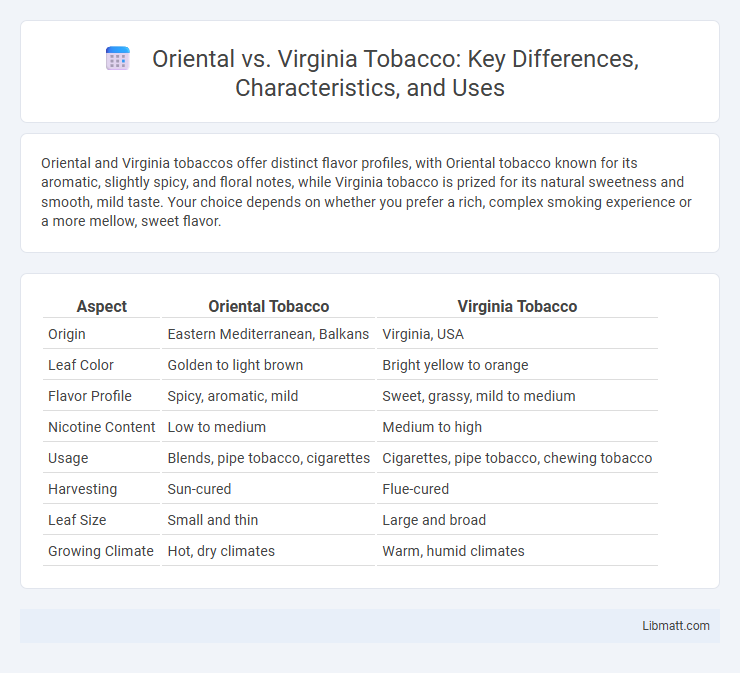Oriental and Virginia tobaccos offer distinct flavor profiles, with Oriental tobacco known for its aromatic, slightly spicy, and floral notes, while Virginia tobacco is prized for its natural sweetness and smooth, mild taste. Your choice depends on whether you prefer a rich, complex smoking experience or a more mellow, sweet flavor.
Table of Comparison
| Aspect | Oriental Tobacco | Virginia Tobacco |
|---|---|---|
| Origin | Eastern Mediterranean, Balkans | Virginia, USA |
| Leaf Color | Golden to light brown | Bright yellow to orange |
| Flavor Profile | Spicy, aromatic, mild | Sweet, grassy, mild to medium |
| Nicotine Content | Low to medium | Medium to high |
| Usage | Blends, pipe tobacco, cigarettes | Cigarettes, pipe tobacco, chewing tobacco |
| Harvesting | Sun-cured | Flue-cured |
| Leaf Size | Small and thin | Large and broad |
| Growing Climate | Hot, dry climates | Warm, humid climates |
Understanding Oriental and Virginia Tobacco
Oriental tobacco, known for its small leaves and aromatic, mild flavor, originates mainly from Turkey, Greece, and Bulgaria, making it a key ingredient in many Mediterranean and Balkan tobacco blends. Virginia tobacco, prominent for its bright, golden leaves and natural sweetness due to high sugar content, is predominantly grown in the United States, Brazil, and Zimbabwe, serving as a base in many cigarette brands worldwide. Understanding the distinct cultivation processes and flavor profiles of Oriental and Virginia tobacco helps in appreciating their unique contributions to tobacco products.
Origins and Historical Background
Oriental tobacco originates from the small-leafed varieties cultivated in Turkey, Greece, and the Balkans, known for its aromatic and spicy character, developed through centuries of traditional sun-curing methods. Virginia tobacco, also called bright tobacco, began in the United States in the 17th century, characterized by larger leaves and a sweet, mild flavor resulting from flue-curing techniques. The historical cultivation of Oriental tobacco reflects regional climate and soil influences, whereas Virginia tobacco's development is tied to industrial-scale farming and curing innovations shaping modern cigarette production.
Botanical Differences
Oriental tobacco plants (Nicotiana tabacum var. orientalis) are smaller with narrower leaves and thrive in hot, arid climates, producing aromatic and spicy tobacco ideal for cigarettes and pipe blends. Virginia tobacco (Nicotiana tabacum var. virginia) features larger, broader leaves with a lighter color, grown primarily in humid regions, known for its naturally sweet flavor due to high sugar content. The distinct leaf morphology and chemical composition between Oriental and Virginia varieties are crucial for their different curing processes and flavor profiles in tobacco products.
Flavor Profiles Compared
Oriental tobacco offers a distinctive aromatic flavor characterized by spicy, earthy, and slightly sweet notes, making it popular in blends that require complexity and depth. Virginia tobacco features a naturally sweet, mild taste with citrus and grassy undertones, often prized for its smoothness and bright flavor profile. Your preference will depend on whether you favor the bold, rich aroma of Oriental or the light, sweet charm of Virginia.
Curing and Processing Methods
Oriental tobacco is typically sun-cured, involving drying leaves directly under natural sunlight to develop its mild, aromatic profile, while Virginia tobacco undergoes flue-curing, where leaves are dried in controlled heated barns to enhance its high sugar content and bright, golden color. Oriental processing emphasizes air-curing techniques that preserve natural flavors and produce a thinner leaf, compared to Virginia's intensive heat-curing that results in a thicker, more robust leaf ideal for cigarette blending. These distinct curing and processing methods influence the chemical composition, flavor intensity, and combustion properties critical for blending in the tobacco industry.
Popular Uses in Cigarette and Pipe Blends
Oriental tobaccos, known for their aromatic and spicy profiles, are primarily used in cigarette blends to add complexity and enhance flavor nuances, often complementing the sweetness of Virginia tobaccos. Virginia tobaccos, characterized by their natural sweetness and light-bodied profile, serve as the foundational leaf in both cigarette and pipe blends, providing a smooth and mild smoke. In pipe blends, Oriental tobaccos contribute distinct exotic notes, while Virginia tobaccos offer a consistent, mellow base that balances the blend's overall flavor.
Geographic Cultivation Regions
Oriental tobacco is predominantly cultivated in the Eastern Mediterranean regions such as Turkey, Greece, and Bulgaria, where the warm climate and sandy soil create ideal growing conditions. Virginia tobacco thrives mainly in the southeastern United States, including states like North Carolina, Virginia, and Kentucky, benefiting from a temperate climate and well-drained, fertile soil. Your choice between Oriental and Virginia tobacco depends on the desired flavor profile influenced by these distinct geographic cultivation regions.
Impact on Smoking Experience
Oriental tobacco, known for its aromatic and spicy flavors, offers a distinctive smoking experience characterized by a mild to medium strength and a rich, complex aroma. Virginia tobacco, prized for its naturally sweet and mellow taste, provides a smoother and lighter smoking profile with a high sugar content that enhances combustion and flavor. The choice between Oriental and Virginia significantly affects the smoking experience, with Oriental contributing rich, exotic notes and Virginia delivering a sweeter, more approachable smoke.
Health Considerations of Each Type
Oriental tobacco contains higher nicotine and sugar levels, potentially leading to stronger throat irritation and a more intense smoking experience. Virginia tobacco, known for its lower nicotine content and natural sweetness, is often considered milder and less harsh on the respiratory system. Health risks such as respiratory issues and addiction remain significant for both types, though the chemical composition influences user perception and potential harm.
Market Trends and Consumer Preferences
Oriental and Virginia tobacco varieties exhibit distinct market trends driven by consumer preferences for flavor and nicotine strength. Virginia tobacco remains highly popular for its mild, sweet flavor and high sugar content, appealing to mainstream cigarette smokers and roll-your-own enthusiasts. You will find Oriental tobacco favored in niche markets for its aromatic, spicy notes, often used in premium blends catering to consumers seeking unique sensory experiences.
oriental vs Virginia Infographic

 libmatt.com
libmatt.com